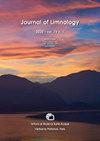Longitudinal recovery gradient of macroinvertebrates during different hydrological scenarios in a downstream river reach
IF 1.1
4区 环境科学与生态学
Q4 LIMNOLOGY
引用次数: 0
Abstract
Macroinvertebrate community composition in regulated rivers is highly dependent on high and low flow events. Significant reduction or augmentation of the flow downstream from a dam can lead to a decrease in the variety of the sensitive macrozoobenthic taxa. Such decreases may lead to a degraded ecological status. In this research, the macrozoobenthic community was investigated in a river section downstream of a multipurpose dam with strategic significance for northeast Bulgaria. Samples were collected for five years from the Golyama Kamchia River, in close proximity to the Ticha dam. Three sampling sites were established in a longitudinal gradient, from 75 to 1770 meters from the dam. Sixteen invertebrate samples were taken between 2017 and 2021. Double sampling (spring and autumn) was conducted in 2019. The goal was to find how macroinvertebrate communities are influenced by the dam-induced modified environmental conditions, from the management of the dam, and which of the parameters is considered to have the strongest effect. Likewise for the study was important to understand longitudinal recovery gradients from the application of the present “minimum acceptable flow – compensation flow” in hydrologically differing years. The main physicochemical parameters were measured alongside the velocity of the water at each sampling site. Additionally, the maintained hydrological regime was explored for a relationship by several hydrological indices with the macroinvertebrate community composition. The analysis of the biological data through 7 biological indices showed that hydrologically sensitive taxa (Ephemeroptera, Plecoptera and Trichoptera - EPT) were very good indicators for damming impact, detecting disturbances not so well differentiated by other type-specific indices and the resulting ecological status. The order Trichoptera was the most influenced taxa group during the study. In 2020 the base flow released from the dam dropped to its lowest level (0.095 m3 s-1 from 0.552 m3 s-1) for an explored 10-year period of hydrology. This event continued for more than a year and led to a rupture of the previously observed recovery gradient. Downstream of the second sampling site, at about 800 m below the dam wall, a decrease in the number of trichopteran families was observed and at the third site, at 1.8 km from the dam they were significantly reduced.下游河段不同水文情景下大型无脊椎动物的纵向恢复梯度
调节河流中的大型无脊椎动物群落组成高度依赖于高流量和低流量事件。大坝下游流量的显著减少或增加可能导致敏感的大型底栖动物类群的种类减少。这种减少可能导致生态状况恶化。在这项研究中,对保加利亚东北部一座具有战略意义的多用途大坝下游河段的大型底栖动物群落进行了调查。五年来,在靠近蒂查大坝的戈尔亚马-坎奇亚河采集了样本。在距离大坝75至1770米的纵向梯度中建立了三个采样点。2017年至2021年间采集了16个无脊椎动物样本。2019年进行了双采样(春季和秋季)。目的是从大坝的管理中了解大型无脊椎动物群落如何受到大坝引起的环境条件的影响,以及哪些参数被认为具有最强的影响。同样,对于该研究来说,重要的是通过在水文不同年份应用目前的“最小可接受流量-补偿流量”来了解纵向采收率梯度。在每个采样点测量主要的物理化学参数以及水的速度。此外,通过几个水文指数探讨了维持的水文状况与大型无脊椎动物群落组成的关系。通过7个生物学指标对生物学数据的分析表明,对水文敏感的分类群(蜉蝣目、Plecoptera和Trichoptera-EPT)是很好的筑坝影响指标,可以检测到其他类型特异性指标所不能很好区分的干扰和由此产生的生态状况。毛翅目是本研究中受影响最大的类群。2020年,在探索的10年水文期内,大坝释放的基本流量降至最低水平(从0.552 m3 s-1降至0.095 m3 s-1)。这一事件持续了一年多,导致之前观察到的恢复梯度破裂。在第二个采样点的下游,在坝墙下方约800米处,观察到毛翼虫科的数量减少,在距离大坝1.8公里的第三个采样点,毛翼虫属的数量显著减少。
本文章由计算机程序翻译,如有差异,请以英文原文为准。
求助全文
约1分钟内获得全文
求助全文
来源期刊

Journal of Limnology
地学-湖沼学
CiteScore
2.70
自引率
6.20%
发文量
12
审稿时长
3 months
期刊介绍:
The Journal of Limnology publishes peer-reviewed original papers, review papers and notes about all aspects of limnology. The scope of the Journal of Limnology comprises the ecology, biology, microbiology, physics, and chemistry of freshwaters, including the impact of human activities, management and conservation. Coverage includes molecular-, organism-, community-, and ecosystem-level studies on both applied and theoretical issues. Proceedings of workshops, specialized symposia, conferences, may also be accepted for publication.
 求助内容:
求助内容: 应助结果提醒方式:
应助结果提醒方式:


